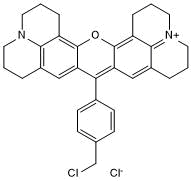MitoMark Red I |
| Catalog No.GC50454 |
Red fluorescent mitochondrial stain; cell permeable
Products are for research use only. Not for human use. We do not sell to patients.

Cas No.: 167095-09-2
Sample solution is provided at 25 µL, 10mM.
Red fluorescent mitochondrial stain. Fluorescence intensity is dependent on mitochondrial membrane potential. Excitation/emission maxima λ ~ 578/599 nm.
References:
[1]. Poot et al (1996) Analysis of mitochondrial morphology and function with novel fixable fluorescent stains. J.Histochem.Cytochem. 44 1363 PMID:8985128
[2]. Buckman et al (2001) MitoTracker labeling in primary neuronal and astrocytic cultures: influence of mitochondrial membrane potential and oxidants. J.Neuroscience Methods. 104 165 PMID:11164242
Average Rating: 5 (Based on Reviews and 30 reference(s) in Google Scholar.)
GLPBIO products are for RESEARCH USE ONLY. Please make sure your review or question is research based.
Required fields are marked with *




